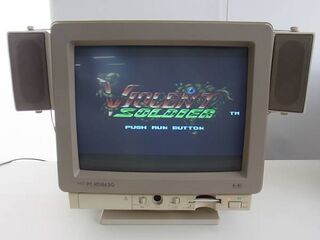PC-KD863G
From NEC Retro
Revision as of 13:48, 11 October 2015 by Black Squirrel (talk | contribs) (Created page with "{{ConsoleBob | logos= | consoleimage=PCKD863G.jpg | imgwidth= | name= | maker=NEC | releases={{releasesPCE | pce_date_jp=1988-09-27 | pce_rrp_jp=138,000 }} }} {{sub-stub}}...")

| ||||||||||
| PC-KD863G | ||||||||||
|---|---|---|---|---|---|---|---|---|---|---|
| Manufacturer: NEC | ||||||||||
|
This teeny-tiny article needs some work. You can help us by expanding it.
The PC-KD863G is a PC Engine built into a CRT computer monitor.
Hardware
As already suggested, the concept behind the PC-KD863G was to allow Japanese customers to play PC Engine games without the need to buy both a console and television separately. It is largely considered to be a novelty device - not the first console/screen hybrid system to be released, but arguably the first to act as a PC monitor rather than a traditional television. It can, for example, be used with NEC's wide range of PC-8800 series or PC-9800 series computers, among many other things.
For its time, the PC-KD863G offered the clearest method for playing PC Engine titles, as an RGB signal comes straight from the console onto the screen, without the distortions usually witnessed with RF or composite video technology. By default a regular, 1987-spec PC Engine outputs its video signal solely in RF - it would be many months until further RGB options would become available. Furthermore it comes equipped with stereo speakers - monaural setups were still common in Japan at the time.
Today the PC-KD863G is not much more than an expensive novelty item, being largely incompatible with later PC Engine add-ons and being rendered obsolete by newer monitor standards.
| PC Engine |
|---|
| PC Engine (1987) | CoreGrafx (1989) | CoreGrafx II (1991) X1 Twin (1987) | PC-KD863G (1988) | Shuttle (1989) | GT (1990) | LT (1991) |
| Add-Ons |
| AV Booster (1988) | Interface Unit (1988) | Ten no Koe 2 (1989) | Backup Booster (1989) | Backup Booster II (1989) | Ten no Koe Bank (1991) | Memory Base 128 (1993) |